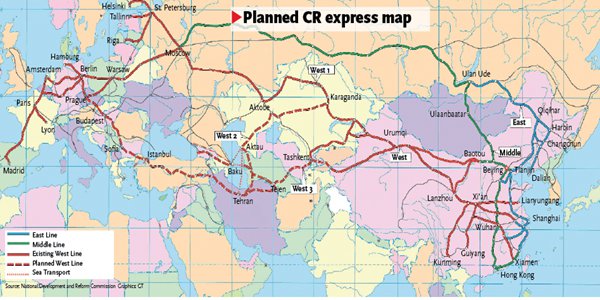
Situation not sustainable in longer term, experts say
As more cargo trains link China and Europe, issues such as government subsidies are attracting more media attention, and experts told the Global Times Sunday that while subsidies may be understandable in the short term, they should be avoided in the long term.
Subsidies have been listed as one of four issues that are constraining the development of new logistics options between China and Europe, the International Business Daily reported on December 2. The other three issues are documentation, operator's responsibility and low utilization rate of returning trains.
The subsidies provided by local governments average 7,500 ($1,086) to 10,000 yuan for a 20-foot equivalent unit container (TEU), and sometimes the figure is as high as 20,000 yuan. A cargo train hauling 80 TEUs needs at least 600,000 yuan in subsidies, the paper said. A subsidy without some fixed termination date isn't sustainable, it noted.
It's reasonable that governments provide subsidies to China-Europe cargo trains to support their normal operations at the initial stage when the market is not mature, said Wei Jigang, a research fellow with the Development Research Center of the State Council.
"Currently, market demand is insufficient, especially in cities that are not transportation hubs, and the costs of China-Europe cargo trains are very high. Hence, it's a sound choice for carriers to maintain operations by accepting subsidies," Wei told the Global Times on Sunday.
However, subsidies are unsustainable in the long run, experts noted.
Cargo trains between China and Europe have become an important platform for many of the inland provinces in their opening-up.
Via CR Express, a number of Chinese cities in West and Central China, such as Southwest China's Chongqing Municipality and Chengdu, Central China's Zhengzhou and Wuhan, and Northwest China's Xi'an, are steadily expanding their cross-border logistics and trade through this method.
The freight trains have also opened a window for exports by Northwest China's Xinjiang Uyghur Autonomous Region.
"Local governments compete fiercely to elevate their status in what they perceive as the logistics channels of tomorrow, but the reality is that freight demand is scare in some cities. In this sense, ongoing subsidies to support these trains leads to a waste of resources," noted Wei.
Subsidies are used as incentives by some localities to grab transportation orders in the domestic market. And in this case, cargo is following routes that don't make sense from a market perspective and wasting resources, the International Business Daily newspaper said.
On the other hand, demand hasn't fully materialized, according to a report by the Economic Information Daily in July that cited executives working on a route that links Central China's Zhengzhou and Europe.
Current cargo volume between China and Europe is about 300 million tons annually, and it is primarily carried out by sea. Trains only account for 10 percent, a low level that reflects the underdeveloped market, the report said.
Wei argued that the central government can make overall plans by letting some cities transport their products to a transportation hub that will handle the shipments abroad.
Subsidies should be ended because they don't help carriers reduce their costs, He Weiwen, an executive council member at the China Society for the WTO, told the Global Times on Sunday.
"Currently, China-Europe cargo trains are very expensive to operate, and subsidies cover part of their costs. But these companies can't really cut costs unless they enlarge their market share and boost demand," He noted.


















































